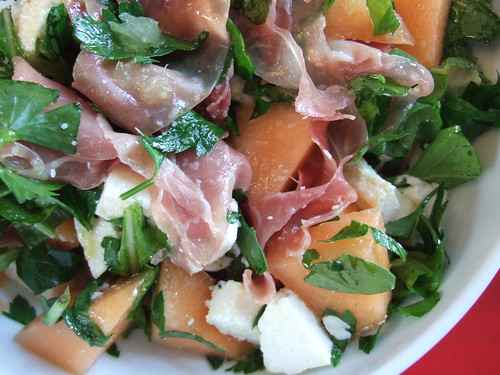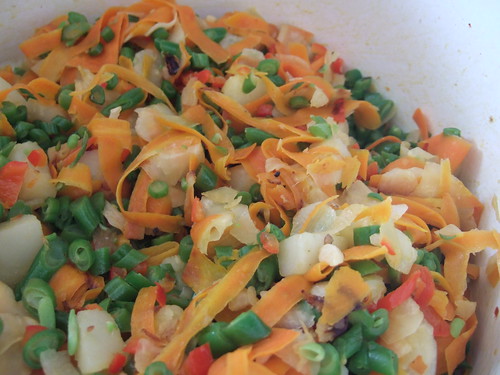I wanted to accomplish two things with this version of the Shanghainese xiao long bao, or soup dumplings: make my own dumpling wrap from scratch and put a spin to it by using butternut squash soup for October’s Supper with Strangers instead of the traditional stock made from pork skin and chicken broth. Although I was proud at making my first edibles ones without trying too hard, the soup didn’t burst as much as I would have liked. But now that I know that I’m capable of making them, I’ll take some other time to make the traditional version and make my Chinese friends proud.
Allow yourself some extra time to make the butternut squash soup and the ham hock filling first and save the dumpling-making a couple of hours before serving. (I made a whole batch of soup and only used 2 cups for the xiao long bao.) For my first try, I kneaded the dough by hand, but for our Supper, I found a pasta maker extremely helpful in making the dough as thin and pliable as I needed it to be. A small 2-layer bamboo steamer in Chinatown is $10 and it can fit about ten xiao long baos.
Ingredients:
For the roasted butternut squash soup:
1 butternut squash, peeled, seeds removed, sliced in half
1 carrot, chopped
2 ribs of celery, chopped
1 yellow onion, chopped
fresh thyme
1 tbsp powdered gelatin
oil, salt, pepper1. Make the butternut squash soup. Drizzle some oil on squash and season with thyme, salt and pepper. Roast squash in oven until tender, about 30 minutes. Remove from heat and let cool. When cool enough to handle, scoop out the squash meat to a bowl.
2. Combine carrot, celery and onion in a large stockpot with enough water to cover. Bring to a boil. Simmer until carrot is soft. Add the squash meat. Season with thyme, salt and pepper. Cook and stir occasionally while mashing some of the vegetables with the back of a wooden spoon. Remove from heat and let cool.
3. Start with a small batch of the squash mixture and purée in food processor. Return each batch to another stockpot and simmer again. Add more water to make a soup consistency. Season to taste.
4. Transfer 2 cups of the soup to a small saucepan for the xiao long bao. Add powdered gelatin and let sit for 2 minutes. Stir bring to a simmer. Remove from heat and let cool. Pour into a small ice cube tray and refrigerate until ready to make the xiao long baos. Serve the rest as a soup starter another day.
For the ham hock:
3 smoked ham hocks, soaked in water overnight, then drained when ready to use
1 carrot, chopped
2 ribs of celery, chopped
1 red onion, chopped
3 bay leaves
1 small knob of ginger, peeled, thinly sliced
1 tsp soy sauce
1 tsp sesame oil1. Make the ham hock filling. Combine ham hocks, carrot, celery, onion and bay leaves in a large stockpot with enough water to cover. Bring to a boil. Remove the impurities that rise to the top using a slotted spoon. Simmer for 2 to 3 hours or until the ham hocks are tender. When cooked, set the ham hocks aside and let cool. Discard the rest.
2. When cool enough to handle, remove the ham hock meat from the bones and roughly chop. In a small bowl, combine meat with ginger, soy sauce and sesame oil. Refrigerate until ready to make the xiao long baos.
For the xiao long bao wrappers:
2 cups of flour, and more for your work surface
1/3 cup of hot water
2/3 cup of room temperature water
5 leaves of napa cabbage1. Make the xiao long baos wrappers. Sift the flour into a large mixing bowl. Add the hot water and incorporate with your hands. Add the other 2/3 cup of water and mix to make dough. On a floured surface, use your hands to knead the dough for 10 minutes or until it becomes soft, smooth and bounces back slowly when you poke with your finger. Cover with plastic wrap and let it sit for 30 minutes.
2. Divide dough into 3 portions. Using one portion at a time while rest of the dough is covered in plastic wrap, roll into a snake. Chop the snaked dough in 1-inch pieces. Feed each inch into a pasta maker and roll out, using thickest setting first and moving on to the 2nd and then the 3rd, until the dough is thin but pliable enough. I made one wrapper and assembled a xiao long bao one at a time to keep the dough from drying up.
3. Assemble the xiao long baos. Fill each wrapper with 1 tbsp of ham hock filling and a cube of butternut squash soup gelatin. Pinch and pleat the edges of the wrapper and twist to seal. Set assembled ones in a large bowl covered with a wet paper towel to keep moist until ready to steam.
4. Boil a large pot of water. Line each layer of the bamboo steamer with napa cabbage leaves. Place a few xiao long baos on each layer, cover and put on top of the pot of boiling water to steam for 10 to 15 minutes. They are cooked when translucent and moist.
Related post/s:
October Supper with Strangers photos on Flickr
The process of making xiao long bao photos on Flickr









